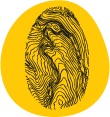
Changing farming landscapes in the Mediterranean: the Portofino and Lesvos case
The Mediterranean landscape has been rapidly changing over the past decades. Many regions saw a population decline, which resulted in changing land use, abandonment of marginal lands and colonization by shrubs and tree species. Labour intensive practices such as maintenance of terraces and dry stone walls, or livestock herding and transhumance decreased or were abandoned. This caused changes in landscapes, typical features like farming terraces, olive yards, and upland grasslands have been decreasing over the past 50 years. This results in a declining biodiversity and loss of traditional landscapes, typical for the Mediterranean region.
In this paper we assess the landscape changes that took place in two areas, in Portofino, a typical Mediterranean landscape on the Italian Riviera, and Lesvos, a Greek island near the Turkish coast. The current Regional Park of the Monte di Portofino is subject to strong pressures of tourism and urban areas, and is at risk of substantial loss of its traditional landscapes, scenic beauty and cultural heritage. The small scale terraced agriculture has transformed in gardens for semi-residential housing. Lesvos has a century-old farming system, which is adapted to the local arid conditions. However, in recent years the old terrace-based farming is not profitable anymore, which leads to a lack of maintenance and thus a decline of the terraced landscape.
We compared land use maps and aerial photographs over the past decades to quantify the land use changes. Additional information was acquired from farmer interviews and literature. Besides important environmental changes in both areas it seems that the main changes are related to societal changes in the appraisal of agricultural land use, and to the incidence of urban expansion, tourism and recreation. These diffuse processes are a result of policy measures and autonomous societal transformations. This is confirmed by the results of two interview surveys: between 1999 and 2012 agricultural land use in Portofino regional Park and buffer zone practically disappeared, and the associated landscape changes are perceived as a substantial loss of character and identity. Landscape-ecological analysis moreover reveals that biodiversity in this area is largely related to agricultural land use and forest management on the one hand and absence of disturbance on the other. This problem is emblematic for large parts of the Mediterranean, and asks for a comprehensive approach to land use management. Also for Lesvos we observe that farming is in decline, however, farming is still more viable probably as a result of the farming conditions which are relatively better.
Proper interpretation and evaluation of these results makes it possible to obtain and ascertain an optimised management of Portofino’s environmental heritage, ever more adequate in transferring appropriate knowledge for the maintenance of these resources.
Kizos T, Dalaka A, Petanidou T (2009) Farmers’ attitudes and landscape change: evidence from the abandonment of terraced cultivations on Lesvos, Greece. Agriculture and Human Values 27(2):199-212
Kizos T, Koulouri M (2006) Agricultural landscape dynamics in the Mediterranean: Lesvos (Greece) case study using evidence from the last three centuries. Environmental Science & Policy 9(4):330-342
Pedroli B, Van der Sluis T, Tagliasacchi S, Vos W (in press) Landscape ecology of the Monte di Portofino
Preiss E, Martin J-L, Debussche M (1997) Rural depopulation and recent landscape changes in a Mediterranean region: Consequences to the breeding avifauna. 12(1):51-61
Van der Sluis T (2002) Development of a methodology to analyse land use options for Monte di Portofino. Wageningen University
